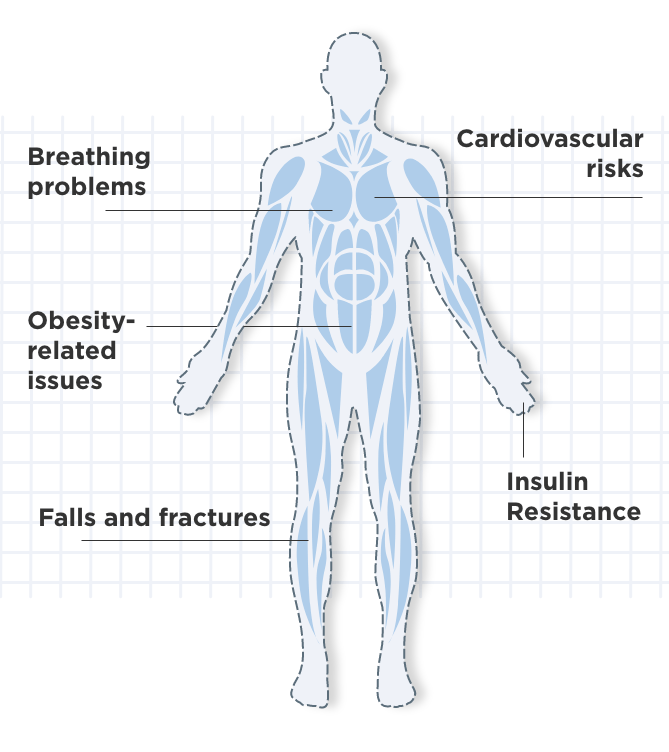
Muscle mass scales
Explore our muscle mass scales from Withings. Accurately monitor your body composition and achieve your fitness goals with advanced...
Muscles are often described as the “engine” of your body’s fat and calorie burning mechanism. Increased muscle mass can lead to less body fat, a stronger immune system, improved energy levels, and reduced stress.

If you want to grow muscle or manage muscle mass, we’ll tell you about the health effects of muscle, explain the dangers of age-related muscle loss, dive into ways to measure muscle mass, including bioelectrical impedance, and give you tips on achieving high muscle mass.
Muscle is more dense than fat, which means that if you’ve increased your activity levels but aren’t losing weight, it may be due to the fact that you’re adding lean muscle mass—a positive trend for your health in the long run.
If you have low muscle mass, or want to manage muscle mass, what can you do? Let’s look at how muscle mass is measured, examine its benefits, and see what you can do to grow muscle mass.
Get the science behind muscle growth mechanisms and see their significance to your health.
Put simply, muscle mass is the amount of muscle in your body, including skeletal muscles, smooth muscles, and cardiac muscles.

It can be measured as part of your total body composition, along with fat mass and bone mass.
Skeletal muscle consists of muscle fibers, or myofibers—each of which is a single muscle cell—that are bound together and wrapped by connective tissue called the epimysium.
Approximately 20-80 muscle fibers are grouped together to form a fascicle. The muscles are separated by connective tissue outside the epimysium, called fascia. Tendons connect muscles to bone.
These terms are often used interchangeably, but they are different. Lean body mass includes muscle mass—as well as the weight of your organs, bones, skin, and body water. Essentially, it’s everything except body fat. Muscle mass refers to only the weight of your muscles.
Muscle mass can be measured in a doctor’s office or clinical setting using a variety of methods.
A review in the Journal of Clinical Medicine lists several methods, including BMI—a flawed method, because it may underestimate fat-free mass depletion—as well as mid-arm muscle circumference, bioelectrical impedance analysis, dual-energy X-ray absorptiometry, and computed tomography.
Other options for measuring your muscle mass include calculating your body fat percentage, using a U.S. military formula, or getting an MRI. At home, muscle mass percentage may be measured via a smart scale that calculates body composition.
Everyone knows that muscle mass plays a role in increased workout performance, but it can play a role in your overall health, too. In an article in The American Journal of Clinical Nutrition, “The underappreciated role of muscle in health and disease,” researchers point out that muscle plays an important role in whole-body protein metabolism, which is particularly important when it comes to your body’s response to stress—including recovery from trauma or illness.
Muscle mass can also play an important role in the prevention of certain conditions and chronic diseases. In addition, gaining muscle mass can give you more energy and stronger muscles to perform daily tasks.

Unfortunately, low muscle mass can negatively impact your overall health. In a review article in the Annals of Medicine entitled “Implications of low muscle mass across the continuum of care: a narrative review,” the authors indicate that low muscle mass can have negative effects across the healthcare continuum:
“Low muscle mass is associated with outcomes such as higher surgical and post-operative complications, longer length of hospital stay, lower physical function, poorer quality of life and shorter survival.”
Another study, in PLoS One, noted that “muscle mass mediates associations of BMI with adiposity and mortality and is inversely associated with the risk of death.”
And muscle loss tends to increase as we get older. Sarcopenia, or age-related muscle loss, begins at age 30—some estimates say it starts even earlier, at 25—and causes muscle loss of as much as 3 to 5% per decade. Untreated sarcopenia, as well as osteoporosis, can lead to an increased risk of falls and fractures.
In a review published in Frontiers of Endocrinology, the authors note: “Musculoskeletal aging is a major public health ... strain due to the significant demographic modifications in the population, and it is linked to high risk of falls, loss of autonomy in elderly individuals and institutionalization with small health outcomes.”
In addition to age, your gender, height, and weight may play a role in how much muscle mass you have. For example, a study in the Journal of Applied Physiology found that men have more skeletal muscle mass than women, and that gender differences are greater in the upper body.
Generally, the normal range for muscle mass is as follows:

When you exercise, you are essentially causing trauma to your muscles, and your body works to repair or replace the damaged cells.
During this process, the trauma activates satellite cells—located outside your muscle fibers—which then begin to multiply.
Some of them fuse to your muscle fibers to form new muscle fibers and repair damaged ones, and the thickness and amount of your muscle cells increase.
Exercise can help to boost the immune system—in part because of muscle mass. In a 2019 review in the Journal of Sport and Health Science, the authors noted that exercise has an anti-inflammatory effect, and “habitual exercise improves immune regulation, delaying the onset of age-related dysfunction.”
Why? Multiple studies note that the proteins in muscle mass may be used by the immune system to respond to injury. In “The underappreciated role of muscle in health and disease,” the authors indicate that “altered muscle metabolism plays a key role in the genesis, and therefore the prevention, of many common pathologic conditions and chronic diseases.”
Many studies have shown that exercise may relieve stress and anxiety. A 2014 study in Frontiers of Psychology, “The anxiolytic effects of resistance exercise,” showed that muscle-building exercise—specifically, resistance training or strength training—has anxiety-reducing effects.
And a 2018 study in JAMA Psychiatry found that people who had mild and moderate depression who performed resistance training two or more times a week saw a significant reduction in their symptoms.
So exercise that increases your muscle mass may have mental health benefits, too.
You may have heard that excess body fat may lead to type 2 diabetes, and exercise can help lower your risk of both—but did you know that muscle mass may be key to regulating your glucose?
According to a report in The Journal of Clinical Endocrinology & Metabolism, very low muscle mass is a risk factor for insulin resistance, and “higher muscle mass (relative to body size) is associated with better insulin sensitivity and lower risk of pre- or overt diabetes.”
The takeaway? Strength training may help you better regulate glucose.
Strength training can help to build muscle mass—but if you’ve never done it, beginning a regimen may seem intimidating. So how can you start? First: Be sure to ask your doctor before starting a new exercise routine.
If you’re looking to lose excess weight as part of your fitness journey, consider burning body fat by setting weight goals and managing caloric intake. WebMD recommends hiring a fitness trainer who can teach you how to exercise properly, especially if you’re interested in lifting. You may choose to use resistance tubing, free weights, exercise machines, or no equipment at all. Don’t forget to warm up, use the proper equipment, and rest between sessions.
In addition to exercise, nutrition may play a role. In a report in Essays in Biochemistry, the authors note: “Timing of ingestion, co-ingestion of nutrients and the type of protein may all influence protein accretion” in building muscle. They also suggest creatine supplements in combination with resistance exercise may increase muscle mass.
Muscle mass benefits your immune system, and it can have other health benefits, too—including increasing insulin sensitivity and delaying age-related muscle loss. Whether you’re trying to grow muscle or preserve muscle, weight training and strength training may help. Consider talking to your doctor to create an exercise routine that’s right for you.

Muscle mass scales
Explore our muscle mass scales from Withings. Accurately monitor your body composition and achieve your fitness goals with advanced...

Healthy body composition: What it is and how to improve it
What is body composition? Learn how to measure it, what defines a healthy body composition, and tips to improve your fat, muscle, and water...

What is BMI? Understanding normal Body Mass Index for men and women
What is BMI? Body Mass Index helps determine if you're underweight, normal weight, or overweight. Learn how BMI works for men and women.
Join millions of users who are improving their health with Withings. Sign up to discover the entire Withings ecosystem, our latest products, and exclusive offers.
By registering, you agree to receive advertising e-mails from Withings. However, if you change your mind, you can unsubscribe at any time.

